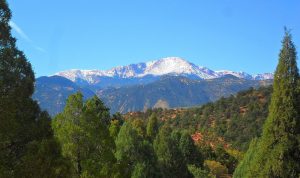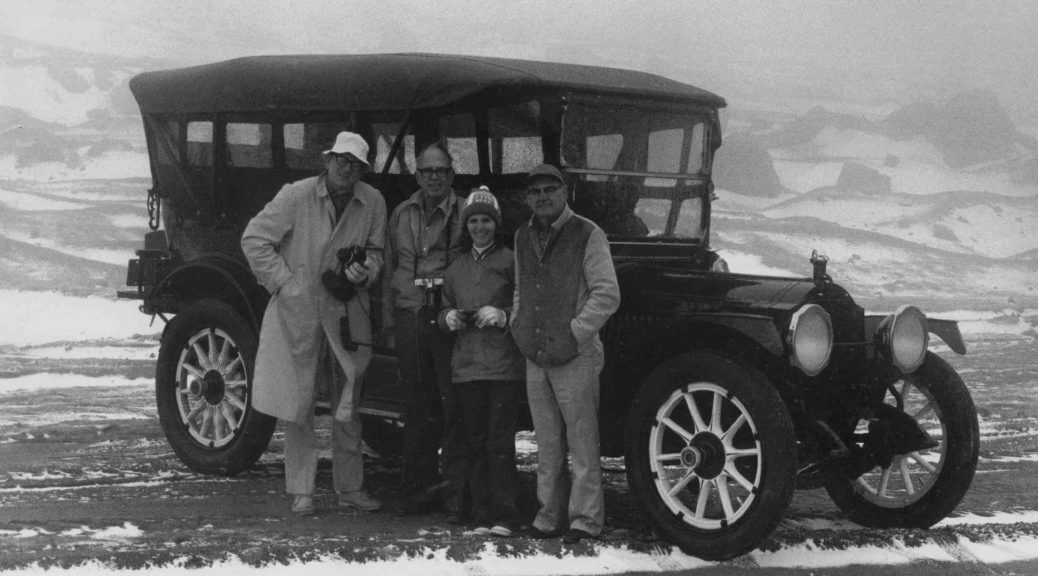
Don Weber, RIP: Storming Pikes Peak, 42 Years On
Arrivederci, Don
Don Weber of San Antonio, a sterling gentleman of the old school, died December 10th at the age of 90. Those who miss him may like to leave a few words on his permanent legacy page. There you will also find details of his extraordinary life.
In Don Weber’s memory, we thought it would be a nice thing to reprint my article on storming Pikes Peak in his 1914 Packard Six Model 1448 on the 1976 Glidden Tour. It first appeared in my sixth issue as editor of The Packard Cormorant, Spring 1977. It reappeared in issue 174, First Quarter 2019, edited by my friend and successor, Stuart Blond.
That trip up the mountain, now so long ago, stands out hair-raisingly in the memory. Happily, we still had the photos—all of which, with my other Packard papers and materials, are in trust for the Packard Motorcar Foundation—the wonderful non-profit enterprise which preserves Packard history including the most significant part of the famous Packard Proving Grounds in Utica, Michigan. I recommend this institution to anyone who cares about cars.
Glidden Tour 1976
When Mr. Weber said he was planning to scale Pikes Peak in his 1914 Packard 1448, he was asking for riders. It didn’t take much persuading, because Don is a hospitable gent, happy to have fellow autoholics on board. The Packard’s ascent proved to be a cinch. But it was a ride none of us will ever forget.
In 1976’s annual Glidden Tour revival, the venue was Colorado Springs: a “hub tour,” with five separate routes beginning and ending at the Four Seasons Motor Lodge. We arrived Tuesday night, amazed the next morning to see the magnificent Rockies all around us, on a bright, clear, mild September day.
The parking lot was swarming with cars. Glidden Tours now accept any pre-World War II automobile, but this is really a brass car event (built through, say, 1918 or so). Among 326 registered cars, Packard had 32 or ten percent, the second most popular make after Ford.
As far as the Weber crew were concerned, the first four days were just a shakedown for the big event: the Pikes Peak climb the last day. This is no pushover, even for a modern car, and the road toward the top is gravel- surfaced, bringing groans of dismay to owners of fastidiously restored antiques. For Don Weber, it was all mere bagatelle. “I didn’t come all the way from Texas,” he declared, “to play chicken with a lil’ ol’ mountain.”
Behind the Wheel
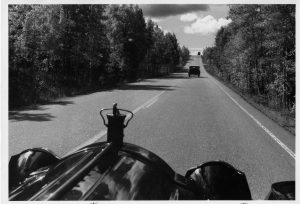
One day’s drive took us through Franktown, Castle Rock and back via Perry Park and Palmer Lake. We were cruising along behind a huge Pierce-Arrow 66, at about 50 mph, when an idea dawned on my Texan friend. “Want to take over?” he queried above the roar of the cut-out.
“Sure,” I said, plunging toward the precipice and not knowing it.
“Okay, you got it,” Don replied, standing up and shifting toward my seat!
Small piece of advice: Don’t learn to drive a Packard Six by sliding over from the passenger’s side to take the wheel of a seven-passenger touring car moving at 50 mph, closely following a Pierce-Arrow. It could be embarrassing.
Dropping into the leather seat, I grabbed hold of the wheel. This is always a good idea when dropping into the driver’s seat at 50 mph. The Six responds well to steering input, but there is no return action. Far in the distance, now, I saw what I most feared: a red light! “Don, howinhell do I stop this thing?” “Nothing to it. Just use the footbrake, and if that’s not enough grab hold of the handbrake on the outside. It works on the tranny.”
I used the footbrake. Nothing happened. Packard brakes weren’t the grabbiest things back in 1914. I used the handbrake. And the monster quickly drew up, but the light had changed. I groped for second gear, found it, ground into it—and kept on going past the prescribed right turn.
We coasted to the right side of the road and turned into a gas station. Theory: duck around the back of the station, rejoin the missed righthand road. It worked, but we had a near miss with an AMC Pacer in the back lot. If a 1448 ever gets hit by a Pacer, it will have to go to a body shop to have it taken out.
“Boss of the Road”
Once you get the hang of it, the Six is an easy car to drive. The handling, while not sophisticated, is positive with not too much body roll. Further on into the mountains, Don was pointing the car into fast, negative camber bends at 50-60 mph without so much as lifting his foot from the accelerator. The 1448 responded ably. The foot brake (operating on rear wheels only) is sufficient if you have enough time to anticipate a stop. The progressive three-speed gearbox never heard of Synchro-mesh, but with a little practice you can whip upward in the gears without a clash; downshifting, however, is another matter. You must double-clutch, and time it properly.
The 1912-15 Sixes were the biggest cars Packard ever built, in displacement (525-cubic inches) and in dimensions. One model, on a 144-inch wheelbase, was offered as a runabout. That kind of wheelbase results in a two-seater slightly shorter than a Bugatti Royale. Performance was excellent, with 60 mph reachable in less than 30 seconds and sustainable on grades as steep as one-in-ten. A noticeable difference in performance occurs when the cut-out is released; at 50 mph say, the car roars and spurts forward.
Heading for the Summit

Friday, September 25th dawned chilly, and we put up the side curtains and top. Off we went, northwest on U.S. 24, past the Garden of the Gods, Manitou Springs, Ute Pass and Cascade. Checking in at the Pike’s Peak Toll Road we were told of a “slight snowstorm” at the summit. The gatekeeper, looking appreciatively at the Packard, told us we’d make it with ease.
Up we drove. “You will have no use for overdrive on this mountain,” we read in a brochure, “but be sure it is out.” It would have been if we had one, but we compromised by using the cut-out for extra power.
At 9,000-feet we stopped to look down at Crystal Creek Dam. The Packard wasn’t even steaming, and had come along in second or third most of the way, overhauling Hupps, Fords, and a lone but determined Brush runabout en route. All was well. At 11,000-feet we had our first view of the Continental Divide. The Packard gulped a bit of water, but showed no sign of serious distemper.
A little further and the sun was gone. It began to rain, then, and as we ascended, to snow. We rolled into Glen Cove (11,425-feet), the lunch stop. Antique cars were everywhere in various stages of fright or determination. The Glen Cove crowd was hesitating on their ascent to the summit (14,110-feet). The snow had started in earnest. A glimpse of what awaited us was a returning 1928 Bentley tourer, mud-bespattered, looking as if it had come from one of those muddy English trials.
Breaking up the pit stop was an impatient Don Weber: “Let’s get a move on before they close this lil’ ol’ mountain down.” The crew agreed, and piled into the Packard.
Blizzard Conditions
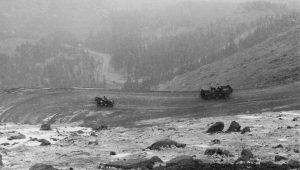
What happened then is only a blur. We look upward and see a long string of spindly antique cars trailing nose to tail on a diagonal ascent up a treeless mountaintop. “How far is that?” I ask Don, who grins and puts his foot down.
It’s snowing harder, and at 12,000-feet it’s a full-blown blizzard. Rags come out, and we start wiping the windshield. There are no wipers, of course. Don finally pulls over to let me get out and wipe the outside, so he can see a little. In the process I look over my shoulder at a yawning chasm called “Bottomless Pit.” I shout to Don, “Drive a little more to the left.” Don laughs and beckons me back inside.
Onward… Can’t see anything now. Don peers through a little clear spot in the windshield as his passengers huddle. We’ve passed 13,000-feet, and it’s snowing harder than ever. The Packard isn’t at all bothered by this, and neither for all I can tell, is Don. He’s just there for the drive, even if he can’t see out the bloomin’ windshield.
“Turn this Car Around!”
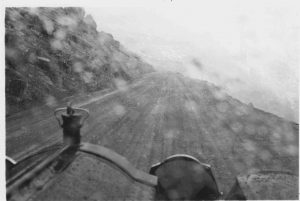
Somewhere about 13,500-feet, the world is one frozen cloud of vapor. The Packard, never stopped by anything mechanical, is finally halted before a burly policeman. “You can’t go any farther,” he shouts through the howling gale. “The summit’s closed down tight. We’re working the cars down almost by hand.”
I sigh my relief, but Weber is still in there punching. “I came all the way from Texas for this,” he hollers back at the gendarme. “You mean I gotta stop 500 feet from the top because of a little snow? Come on, man—Ah’m a Texas Ranger!”
It is useless, thank the Lord. The policeman is taking no guff. I breathe another sigh, but Don just laughs: “This car could make it to the top of Everest.”
We shiver in front of our wonderful Packard at 13,650 feet, the snow and wind and gale all around for photographic documentation. It’s been a grand ride.
On the way down there is some concern about the Packard’s brakes, and indeed strange smells emanate from the direction of the rear wheels. But Don keeps the car well in hand with the transmission brake, and it’s a safe run all the way back. The snow stops. The sun reappears.
We rejoice at our salvation that night at the awards banquet, where everyone expects our Packard to have won something, but no luck. It seems that forty cars made the summit, and performed at least as well ours. But few of them ran along level roads at 60 mph all day, breezing by the Duesenbergs and Lincolns, captained by the skillful and companionable Don Weber, who drives like no other.
Weber and the Automobile
Don was a dear friend, His determination to get to the bottom of the 1912-15 Packard Six history, exploding prior misinformation, is one reason why Packard: A History of the Motorcar and the Company was so good and accurate. The Six was among the finest cars the old company built. Packard called it “The Soft-Spoken Boss of the Road.”
Barbara and I are so glad we had a chance to be with Don again recently, when he attended my presentation at the Triumph convention outside Dallas in 2016. Although he preferred vintage Italian cars for high speed work, he’d driven out from San Antonio in his Porsche, and not slowly. Don always liked to keep the hammer down. He was himself a Soft-spoken Boss of the Road.
Arrivederci, Don. Correrai ancor piu veloce per le vie del cielo.
